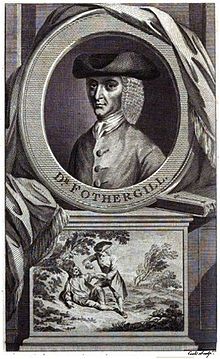John Fothergill (medic)
John Fothergill (born March 8, 1712 in the hamlet of Carr End of the parish of Bainbridge in Yorkshire , † December 26, 1780 in London ) was an English medicin .
Live and act
Fothergill was the second son of John Fothergill, Sr. (1676-1745), a Quaker preacher and farmer, and his first wife, Margaret Hough (1677-1719). He received his early education at Frodsham in Cheshire and the Sedbergh School in Sedbergh , Cumbria . Around 1727-1728 he was an apprentice to a pharmacist named Benjamin Bartlett in Bradfield , South Yorkshire . After his apprenticeship he went to Edinburgh and studied medicine. He attended the lectures of Alexander Monro I , Charles Alston , John Rutherford , Andrew Sinclair (1726–1757) and Andrew Plummer , all students from the school of Herman Boerhaave .
Fothergill graduated in 1736. On Tuesday, August 14, 1736, he received his doctorate in medicine in Edinburgh on the subject of Emeticorum Usu in variis morbis tractandis . This was followed by further training at St Thomas' Hospital in London. After visiting continental Europe, such as Flanders and Holland in 1740, he settled again in London, where he opened a practice. He is said to have treated up to 60 patients daily during the influenza epidemics of 1775 and 1776.
He was a friend of Benjamin Franklin , with whom he was considering a plan for a British reconciliation with the American colonies in 1774 . They met when the Pennsylvania General Assembly , the state parliament of the US state of Pennsylvania , sent Franklin to London in 1757. Upon arriving in London, Franklin fell ill and became a Fothergill patient.
In 1745 Fothergill gave a brief lecture on the work of the Scottish surgeon William Tossach (1700? –1771), one of the first known lectures on the practice of mouth-to-mouth , at the Royal Society of London, of which he was a Fellow in 1763 Ventilation. He was one of the first to identify and describe trigeminal neuralgia in 1765 .
In 1770 he was elected a member of the American Philosophical Society .
As a plant collector and botanist, he established a botanical garden in Upton near Stratford-upon-Avon with rare plants from all over the world.
In 1764 he financed the printing of the English translation of the Bible by Quaker Anthony Purver.
Honors
The plant genus Fothergilla from the witch hazel family ( Hamamelidaceae ) was named after him.
Fonts (selection)
- Botanical Album. Hortus siccus. Upton, Stratford ca.1770.
- A Complete Collection of the Medical and Philosophical Works of John Fothergill . John Walker, London 1781 ( online ).
- The Works of John Fothergill. Charles Dilley, London 1784.
literature
- Fothergill, Samuel, Crosfield, George: Memoirs of the Life and Gospel Laboratories of Samuel Fothergill, with Selections from his Correspondence . D. Marples, London 1843. - contains information on John Fothergill, the author's father
- Harvey, Karen, editor: The Kiss in History . Manchester University Press, Manchester 2005. See Chapter 5: Davidson, Luke, The kiss of life in the eighteenth century: the fate of an ambiguous kiss .
- Remarks on that complaint commonly known under the name of sick-headach. Med Observ Inquir 1784; 6: 103-137
Web links
- Author entry and list of the described plant names for John Fothergill (medic) at the IPNI
- JP Griffin: A tale of two paintings and the London medical scene of the late 18th century. In: Journal of the Royal Society of Medicine. Volume 83, Number 8, August 1990, pp. 520-523, PMID 2078222 , PMC 1292782 (free full text).
- http://www.migraine-aura.org/content/e27891/e45080/e45338/index_en.html
- Images from the History of Medicine. Portrait of John Fothergill (1712-1780)
- Illustration from The works of John Fothergill. , by John Coakley Lettsome (1744-1815) (1783) [Lib. Ref. SR 092.3 FOT LET.A]
Individual evidence
- ^ Biography in English of William Munk
- ^ Doyle, D .: Edinburgh doctors and their physic gardens. JR Coll Physicians Edinb 2008; 38: 361–7 (PDF; 450 kB)
- ↑ Cunningham, Andrew; French, Roger: The Medical Enlightenment of the Eighteenth Century. Cambridge University Press (1990), p. 64-65
- ↑ Biography of Patrick Jucker-Kupper, Switzerland
- ^ Entry on Fothergill, John (1712-1780) in the Archives of the Royal Society , London
- ^ Member History: John Fothergill. American Philosophical Society, accessed August 10, 2018 (year of birth incorrect).
| personal data | |
|---|---|
| SURNAME | Fothergill, John |
| BRIEF DESCRIPTION | English medic, botanist, Quaker and philanthropist |
| DATE OF BIRTH | March 8, 1712 |
| PLACE OF BIRTH | Carr End |
| DATE OF DEATH | December 26, 1780 |
| Place of death | London |
